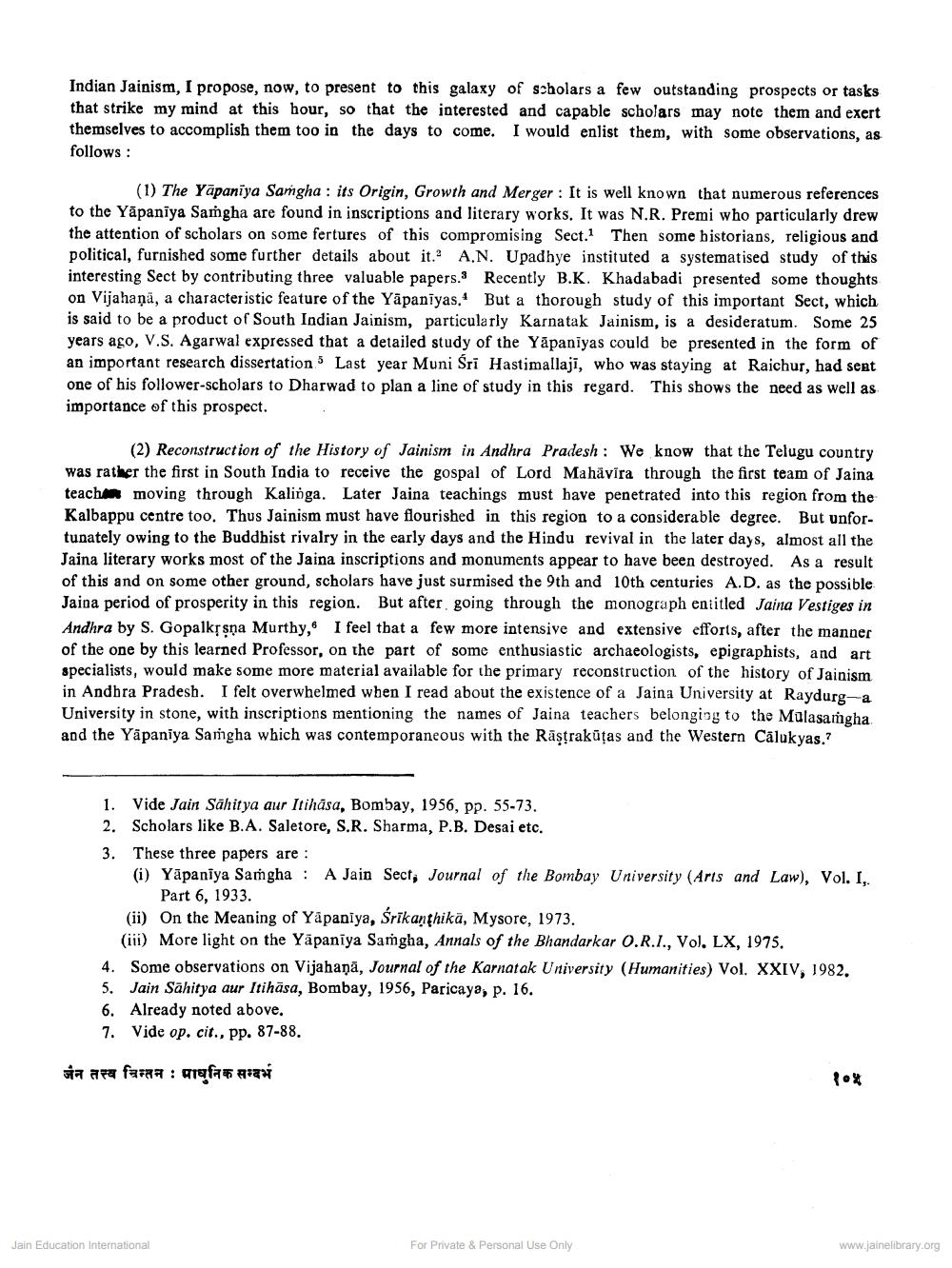________________
Indian Jainism, I propose, now, to present to this galaxy of scholars a few outstanding prospects or tasks that strike my mind at this hour, so that the interested and capable scholars may note them and exert themselves to accomplish them too in the days to come. I would enlist them, with some observations, as follows:
(1) The Yāpaniya Sangha : its origin, Growth and Merger : It is well known that numerous references to the Yāpaniya Samgha are found in inscriptions and literary works. It was N.R. Premi who particularly drew the attention of scholars on some fertures of this compromising Sect. Then some historians, religious and political, furnished some further details about it. A.N. Upadhye instituted a systematised study of this interesting Sect by contributing three valuable papers. Recently B.K. Khadabadi presented some thoughts on Vijahana, a characteristic feature of the Yāpaniyas. But a thorough study of this important Sect, which is said to be a product of South Indian Jainism, particularly Karnatak Jainism, is a desideratum. Some 25 years ago, V.S. Agarwal expressed that a detailed study of the Yāpaniyas could be presented in the form of an important research dissertations Last year Muni Sri Hastimallaji, who was staying at Raichur, had sent one of his follower-scholars to Dharwad to plan a line of study in this regard. This shows the need as well as importance of this prospect.
(2) Reconstruction of the History of Jainism in Andhra Pradesh: We know that the Telugu country was rather the first in South India to receive the gospal of Lord Mahävira through the first team of Jaina teachan moving through Kalinga. Later Jaina teachings must have penetrated into this region from the Kalbappu centre too. Thus Jainism must have flourished in this region to a considerable degree. But unfortunately owing to the Buddhist rivalry in the early days and the Hindu revival in the later days, almost all the Jaina literary works most of the Jaina inscriptions and monuments appear to have been destroyed. As a result of this and on some other ground, scholars have just surmised the 9th and 10th centuries A.D. as the possible Jaina period of prosperity in this region. But after going through the monograph entitled Jaina Vestiges in Andhra by S. Gopalkęsna Murthy, I feel that a few more intensive and extensive efforts, after the manner of the one by this learned Professor, on the part of some enthusiastic archaeologists, epigraphists, and art specialists, would make some more material available for the primary reconstruction of the history of Jainism in Andhra Pradesh. I felt overwhelmed when I read about the existence of a Jaina University at Raydurg-a University in stone, with inscriptions mentioning the names of Jaina teachers belonging to the Malasamgha and the Yāpaniya Samgha which was contemporaneous with the Rāstrakūțas and the Western Calukyas.?
1. Vide Jain Sahitya aur Itihasa, Bombay, 1956, pp. 55-73. 2. Scholars like B.A. Saletore, S.R. Sharma, P.B. Desai etc. 3. These three papers are: (i) Yāpaniya Samgha : A Jain Sect; Journal of the Bombay University (Arts and Law), Vol. I,.
Part 6, 1933. (ii) On the Meaning of Yapaniya, Srikanthikā, Mysore, 1973.
(iii) More light on the Yāpaniya Samgha, Annals of the Bhandarkar O.R.I., Vol, LX, 1975. 4. Some observations on Vijahaņā, Journal of the Karnatak University (Humanities) Vol. XXIV, 1982, 5. Jain Sahitya aur Itihāsa, Bombay, 1956, Paricaya, p. 16. 6. Already noted above, 7. Vide op. cit., pp. 87-88.
जैन तत्त्व चिन्तन : माधुनिक सन्दर्भ
Jain Education International
For Private & Personal Use Only
www.jainelibrary.org




